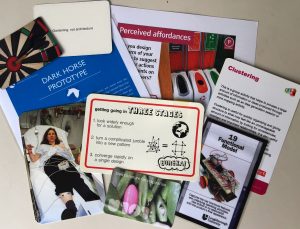
Sets or decks of cards – similar to playing cards – are a long-established type of tool to aid designers. One of the earliest examples is The House of Cards created in 1952 by the famous American designers, Charles and Ray Eames. The OU was early in this field with the Meta Cards, produced in 1972 for the original Technology Foundation course. If you look on the Internet e.g. http://www.deckaholic.com/ you’ll quickly find dozens of card-based design tools. Some of the best known decks include Brian Eno’s and Peter Schmidt’s Oblique Strategies and the IDEO Method Cards.
The early examples of card-based tools, such as Oblique Strategies, focused on stimulating creativity. A few participatory card sets for human-centred computer systems design, such as CARD, were produced in the 1990s. Then after 2000 there was an upsurge, with many card-based tools created to help with user-experience design of websites, apps, etc., such as nForm’s UX Cards, and human-centred design more generally, such as the IDEO Method Cards. Other card sets were produced for specific domains such as game design and graphics, as well as a number to help with team building, collaborative working and futures thinking.
Robin Roy and James Warren are carrying out a review of card-based design tools to discover: what the different types are; how they are supposed to work; and whether they actually help to produce better design outcomes (Roy and Warren, 2017). The different types and modes of operation we discovered include, card sets that provide:
- direct, cryptic or random prompts to stimulate creative thinking
- summaries of general-purpose or domain-specific design methods
- design-relevant information and knowledge in summary form
- checklists, concepts and solutions for specific design problems or domains
Card-based design tools are often used by the people that developed them – mainly academics testing out their cards on students and consultants and consultancy firms working with their clients. The card sets that are most likely to be effective in creating better practical design outcomes are those which summarise domain-specific design methods, or good practices, that designers can apply to real world tasks.
Roy, R. and Warren, J. (2017) Card-based tools for creative and systematic design, Paper submitted 6 November for the Design Research Society DRS2018 conference, Catalyst, University of Limerick, 25-28 June 2018.

Leave a Reply